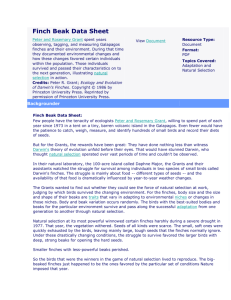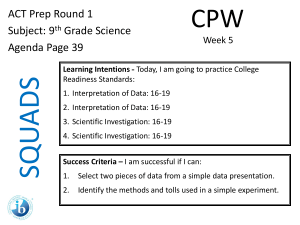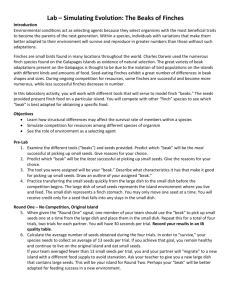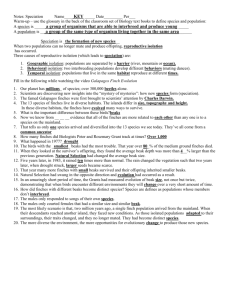File
advertisement
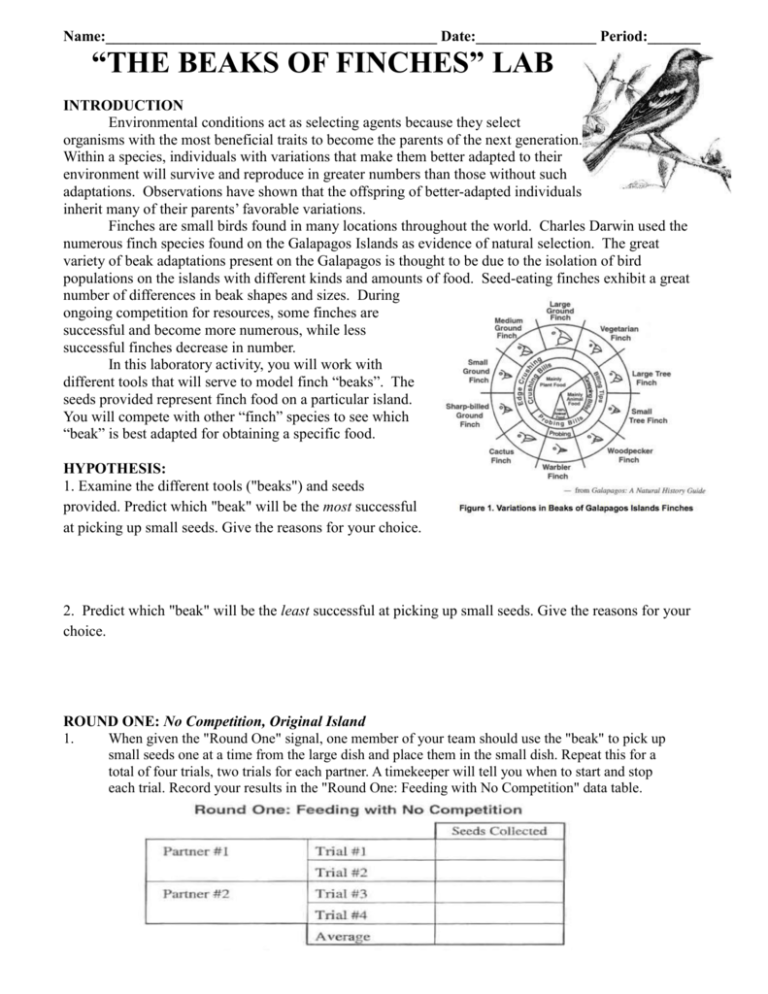
Name:____________________________________________ Date:________________ Period:_______ “THE BEAKS OF FINCHES” LAB INTRODUCTION Environmental conditions act as selecting agents because they select organisms with the most beneficial traits to become the parents of the next generation. Within a species, individuals with variations that make them better adapted to their environment will survive and reproduce in greater numbers than those without such adaptations. Observations have shown that the offspring of better-adapted individuals inherit many of their parents’ favorable variations. Finches are small birds found in many locations throughout the world. Charles Darwin used the numerous finch species found on the Galapagos Islands as evidence of natural selection. The great variety of beak adaptations present on the Galapagos is thought to be due to the isolation of bird populations on the islands with different kinds and amounts of food. Seed-eating finches exhibit a great number of differences in beak shapes and sizes. During ongoing competition for resources, some finches are successful and become more numerous, while less successful finches decrease in number. In this laboratory activity, you will work with different tools that will serve to model finch “beaks”. The seeds provided represent finch food on a particular island. You will compete with other “finch” species to see which “beak” is best adapted for obtaining a specific food. HYPOTHESIS: 1. Examine the different tools ("beaks") and seeds provided. Predict which "beak" will be the most successful at picking up small seeds. Give the reasons for your choice. 2. Predict which "beak" will be the least successful at picking up small seeds. Give the reasons for your choice. ROUND ONE: No Competition, Original Island 1. When given the "Round One" signal, one member of your team should use the "beak" to pick up small seeds one at a time from the large dish and place them in the small dish. Repeat this for a total of four trials, two trials for each partner. A timekeeper will tell you when to start and stop each trial. Record your results in the "Round One: Feeding with No Competition" data table. 2. Calculate the average number of seeds obtained during the four trials. Round off to the nearest seed. In order to "survive," your species needs to collect an average of 13 seeds per trial. If you achieve that goal, you remain healthy and continue to live on the original island and eat small seeds. If your team averaged fewer than 13 small seeds per trial, you and your partner will "migrate" to a new island with a different food supply to avoid starvation. Ask your teacher to give you a new large dish that contains approximately 200 or more large seeds. This will be your island for Round Two. Perhaps your "beak" will be better adapted for feeding success in a new environment. ROUND TWO: Competition In this round, instead of feeding alone, you will be competing for food with finches that have different kinds of "beaks." To simulate this competition, your team will feed from the same dish as one other team. If you were successful during Round One, you will be feeding with other finches on small seeds. If you were not successful, you will be competing for large seeds. 3. In the "Round Two: Feeding with Competition" data table, check the box that indicates whether you are feeding on the original island (small seeds) or on the new island (large seeds). Complete four trials just as you did the first time and record the results of each trial. Again, wait for the time ke eper to tell you when to start feeding and when to stop for each trial. 4. Calculate the average number of seeds obtained during the four trials. Round off to the nearest seed. If your team collected an average of 13 seeds or more per trial, you can go on to Round Three. If your team collected fewer than 13 seeds per trial, you and your partner are now eliminated. ROUND THREE: Increased Competition During this round, you will be competing with all of the other finch species left alive on your island. In other words, all of the finch teams that were successful at feeding on small seeds will compete at one dish containing small seeds. At the same time, all of the finches successful at feeding on large seeds during Round Two will compete at one dish of large seeds. 5. In the "Round Three: Feeding with Increased Competition" data table, indicate whether you are feeding on small or large seeds. Complete four trials as before and record the results of each trial and your average. (see data table on next page) ANALY SIS QUESTI ONS 1. W h at c h ar acteristics of your "beak" interfered with or allowed for feeding success on the original island. Answers will vary depending on the tools provided. Generally large, heavy, slippery, or flat tools are less successful. 2. Name three traits other than beak characteristics that could contribute to the ability of a finch to compete successfully. Answers will vary but may include eyesight, coordination, aggressiveness, speed and motivation. Wing strength, distance from the feeding place to the nest, eye sight, sharp claws, etc… 3. It is very unlikely that all of the beaks within a species of finch are exactly alike. Random mutations and new gene combinations resulting from sexual reproduction are the source of beak variations. Describe at least three beak variations that could randomly appear and further improve your species' chances of survival when feeding on small seeds. Answers will vary but typically will include such traits as being small and light and having a nonskid surface. Medium size, sharp ends, solid and easy to handle 4. Why did some "beak" types survive on the new island (with large seeds) when they could not survive on the original island? They may not have been suited for gripping small seeds but possessed characteristics that made them able to grip large seeds. 5. Why were there fewer survivors at the end of Round Three? There were fewer survivors due to increased competition. 6. One island is populated with two species – Ground Finches and Small Tree Finches. a. What two types of food would you expect to be available on this island? Support your answer. Animal food (Such as insects) and plant food (such as seeds). See picture on front page of lab packet. Ground Finches mainly eat plant food and have an edge crushing bill. Small Tree Finches eat mainly animal food and have grasping bills. b. How might the two native finch populations be affected if several dozen Sharp-billed Ground Finches were to migrate to the island and survive? Provide an explanation. The small ground finches might have to compete with the new Sharp-billed Ground Finches since they have similar food preferences and beaks. They both eat mainly plant food. Therefore, small ground finches population would decrease. c. What might happen to both bird populations if a drought occurred over a period of two years? How might a drought affect their feeding habits? A drought would cause many plants to die, and any organisms that feeds on plants would also decrease in number. Insects would also decrease because plants serve as both their habitats and usual diet. This would also cause the small tree finches to decrease. 7. Explain how this simulation mimics natural selection. Describe specific examples to support your answer. Birds were in competition with each other to survive. The birds that were well suited to the seed type on a particular island were the ones that survived. The birds that did not have the correct “beak types” (adaptations) died. The birds that were well suited would pass on their genes to the next generation. 8. Explain how this activity simulates each of the concepts listed below as they are involved in the process of natural selection. Describe a specific example from this laboratory for each concept. Variation: different beaks, different size seeds Competition: more than one bird feeding at a bowl Struggle for survival: each bird trying to get enough seeds to survive Adaptation: particular characteristics of “beaks” Environment: students, seeds, and the dishes where competition occurs all represent parts of the environment Students = birds, seeds = food, tools = beaks; tables = islands, petri dishes = stomachs Selecting agent: type of “beak” available for feeding and/or type of seed available
